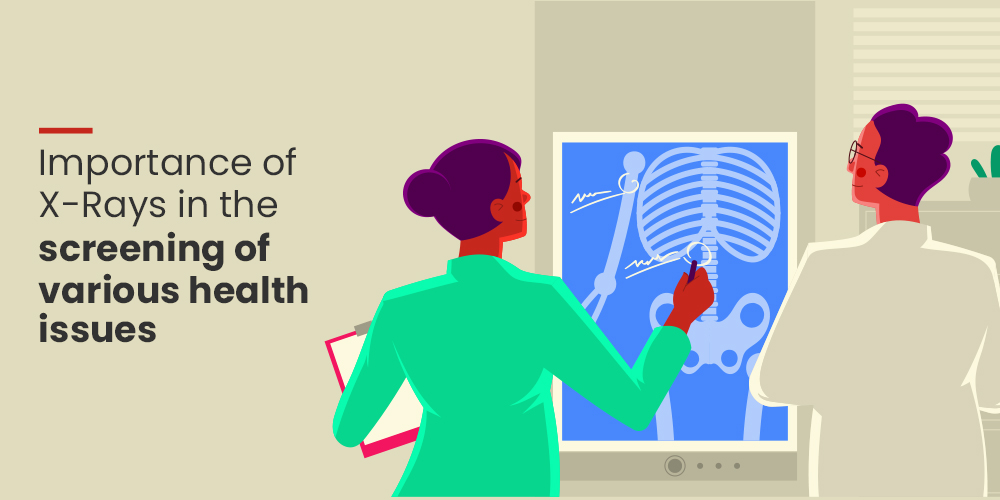An X-ray is a common and non-invasive imaging test that helps in the detection and diagnosis of various medical conditions. With advancements in technology, X-rays are making the jobs of doctors, physicians, and other medical professionals easier, smoother, and faster. X-ray tests use a small dose of radiation to produce images of the internal organs, tissues, and bones.
Benefits of X-ray Tests
X-ray solutions come in different kinds and can serve a plethora of purposes. Besides, enabling the accurate assessment of internal body conditions, X-rays help in the detection of distinct anomalies that are not visible to the naked eye. They are useful in tracing the presence of foreign objects inside the body, along with effective tracking of the progression of certain conditions like arthritis.
They are safe, painless, and easy to use. This effective diagnostic tool can be used in a variety of medical settings like small clinics, hospitals, dental care centres, cancer institutes, and every other medical roof.
X-rays for the Diagnosis of Various Medical Conditions
X-rays are used in many healthcare areas to aid a variety of medical requirements. With technology and innovation, Digital X-rays, Portable X-rays, Computed Tomography, and AI-assisted X-ray solutions are making the waves.
X-rays for Chest
Chest X-rays are generally suggested for the diagnosis and treatment of respiratory conditions like blocked airways, asthma, bronchitis, pneumonia, Emphysema, lung congestion, the presence of air or fluid around the lungs, and lung cancer. The X-ray screening can also help in determining the condition of other organs of the chest like the heart, ribs, and the spine.
Trivitron Healthcare’s Contribution to Chest X-rays
The Mobile Digital Radiography System (DR), Ultisys 3.5 plays a significant role in the initial screening for pneumonia. Ultisys 3.5 is a comprehensive and versatile mobile radiography system that is easy to use and has well-proven features for streamlined operation.
Trivitron Healthcare’s Ultysis Retrofit Kit enables the conversion of the current analog X-ray system into a state-of-the-art Digital Radiography System with retrofit kit. The kit includes a Flat Panel Detector, a Medical Grid Monitor, and user-friendly software for Image Acquisition and Image Processing. This conversion allows for a low-dose and high-resolution digital imaging solution.
Chest X-ray equipment typically includes a box-shaped device that is mounted on a wall and houses either an X-ray film or a digital detector for capturing the images. Alternatively, the X-ray tube may be suspended above a table that supports the patient, with a slot under the table for inserting the X-ray film or digital detector.
Portable X-ray machines are designed to be easily transported to a patient’s hospital bed or the emergency room. They feature a flexible arm that is connected to the X-ray tube. The technician extends the arm over the patient and positions either the X-ray film holder or the image recording plate beneath the patient.
X-Rays for Heart and Bre-asts
X-ray solutions can detect cardiac problems such as heart failure, cardiac congestion, and other heart-related conditions that can range from mild to severe. Breast examination for tumours or cancer can also be easily done with X-ray solutions.
Trivitron’s Contribution to Cardiology & Mammography
The C-Arm is a medical imaging device utilized by healthcare professionals and physicians to perform real-time X-ray imaging during various procedures such as cardiology, orthopaedics, surgery, traumatology, and emergency care. Its name originates from the C-shaped arm that connects the X-ray source to the X-ray detector. This portable equipment allows for easy transportation between different locations, facilitating convenient treatment. As a result, proper maintenance is essential to ensure its longevity.
Trivitron Healthcare’s digital mammography system, Felicia, showcases the capabilities of cutting-edge technology. It is specifically engineered to minimize patient discomfort, simplify the workflow for caregivers, and produce high-quality clinical images with reduced radiation exposure. This advanced system greatly improves diagnostic confidence and enhances surgical precision.
As much as the benefits, there are also a few risks that are associated with X-ray imaging. However, the radiation exposure from X-rays is generally low, and the benefits of accurate diagnosis often outweigh the associated risks.
Patient safety:
- Patients can typically resume their normal activities after an X-ray test. In cases where a contrast medium is used, it is recommended to drink plenty of water to help eliminate it from the body.
- Patients should inform the technicians and physician if they are pregnant. Many imaging tests are avoided during pregnancy due to the potential harm radiation can pose to the developing fetus. If an X-ray is deemed necessary, precautions are taken to minimize radiation exposure to the fetus. In some cases, alternative imaging methods that do not involve radiation or ultrasound scans may be recommended. It is generally advised to avoid X-rays during pregnancy unless it is necessary, as there is an increased risk of childhood cancer in such instances.
- Modern X-ray techniques employ controlled beams to reduce scatter radiation, ensuring that parts of the patient’s body not being examined receive minimal radiation exposure.
X-rays have proven to be an invaluable and essential tool in medical imaging and diagnosis, and their significance will continue to grow in the future of healthcare. As technology advances, X-ray imaging will become faster and more precise, enabling doctors to make increasingly accurate diagnoses and provide improved patient care.
Looking ahead, X-rays will also be utilized to generate 3D images of the body, enabling thorough analysis of organs and systems with greater detail.
X-rays will continue to be a vital tool in the future of healthcare, equipping doctors with the essential data they need to make accurate diagnoses and deliver enhanced care for their patients.

